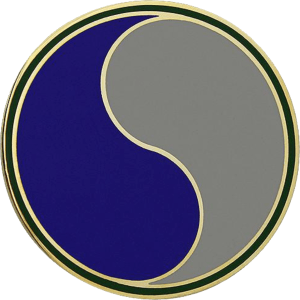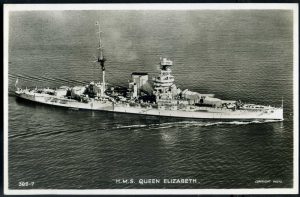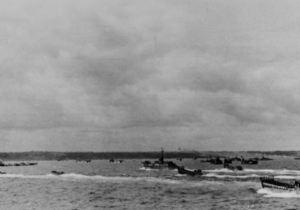Second Lieutenant Richard Ford
K Company, 115th Infantry Regiment, 29th Infantry Division

Richard Ford was born in Erie, Pennsylvania, and grew up during the Great Depression. He had two sisters, and his father ran an insurance agency. At the suggestion of a friend, he attended Clemson College in South Carolina after he graduated high school, as it was cheap. Clemson was a military college, and Ford intended to graduate with a commission so that he could become an officer. However, he became sick as a sophomore, and was prescribed the recently invented sulfa antibiotics to treat his illness. One of the side-effects of the medication was a raised blood pressure. As such, he was unable to pass the medical tests at his college, and couldn’t come back to school in the autumn. Though his family disagreed with his choice, he decided to join the military as an enlisted man.
Ford was given the choice of Hawaii or Panama, and decided to be stationed in Panama as part of a chemical company. He looked back on this as a lucky choice – if he hadn’t have picked Panama, he would have been in Hawaii when Pearl Harbour was attacked. He served along the Canal, in Corozal. There were few motorised vehicles, and the soldiers had to use horses and mules to get around. Bedbugs were rife, and despite washing the bed legs and springs with kerosene every week, the soldiers couldn’t seem to get rid of them. Ford did well, and was asked if he’d like to attend officer’s school. This had been the intent of attending Clemson College, and he said yes. Ford was sent across the Gulf of Mexico, though there was danger to be found in the form of German U-Boats. His ship was attacked, and he had to get on a raft, where he was picked up by a seaplane, and brought to Tampa, Florida.
From there, Ford attended Infantry School in Fort Benning, where some of his instructors were former classmates from Clemson. After being assigned to the 29th Division in Landing, Florida, he went on to New York to cross the Atlantic with Britain as his destination. The ship which would carry them was the Queen Elizabeth, the largest passenger liner ever built at the time. Travelling at an average speed of 26 knots, Ford claims the journey only lasted four days and four nights. He would disembark in the Firth of Forth, only to be loaded up into a train to travel into England. The food was bad enough that the Americans, not used to British rationing, threw their meat pies out of the train’s windows. Ford was sent to Bampton, where he was billeted in a vicarage.

Ford found he was fascinated by the history in the UK – the vicarage and church were purportedly one thousand years old. The pillars of the church had scratches on them, ones he saw mirrored in photographs from the Holy Land. They were made by crusaders, something he found peculiar. He, too, had come to a foreign country on another kind of crusade. The history of Bodmin was of similar interest to him, and despite hearing the phrase “into Bodmin and out of the world”, he especially loved the ancient history on the moors where they did PT.
Being an officer, Ford was left in charge of the men one night when he received a call from Tavistock, where a battalion of his outfit was stationed. The officer on the other end of the phone asked how many cells were in the DCLI barracks. It had transpired that some men needed to be brought down and locked up. The soldiers were white Americans, and after seeing some Black American soldiers at a dance, had fired on the segregated camp for the Black soldiers with a mortar. Ford doesn’t mention what happened to those white soldiers, whether they were court martialled or simply held in the guardhouse for a few days. He does say that he felt bad for Black American soldiers and their treatment, especially after seeing some cross the English Channel for D-Day in an unprotected wooden barge, laden with explosives.
Ford did further training after this, including practice landings at Slapton Sands. It was only later that he discovered the extent of the deaths during Exercise Tiger, where an E-Boat attack and a friendly fire incident resulted in the deaths of at least 749 American servicemen. He also did an officer exchange with the British Army, where he trained with a Norfolk regiment on the Isle of Wight. Ford taught the British Bren Carrier drivers to double clutch, and felt he earned the pay, food, and the batman attending to him with that training. Ford later had the honour of supplying General Eisenhower with overshoes during a rainy, muddy day, though he made a supply sergeant angry when the shoes weren’t returned.
When D-Day loomed, Ford and his men travelled to Plymouth to load onto an LCI. They struggled to approach Omaha Beach and their designated landing site due to the debris in the water, and Ford and his men had to wade onto the sand. Ford says, perhaps self-consciously, that he must have sounded like John Wayne when he called out, “hey boys, follow me!” Their advance up the beach and then a bluff was gruelling, but it was when Ford and his men had to cross the Elbe at St Marguerite that he says he saw some hard fighting for the first time. The river was unprotected and had high banks, and he only just missed being hit by a shell. Many of his men died, and Ford subsequently got into trouble with the Graves Department for burying the remains of a man who had taken a direct hit by an 88 gun. He felt it was the right thing to do, and didn’t care what the Graves Department thought of it. Though men died around him, Ford was considered ‘lucky’. Even when he was lightly wounded, his injury meant he missed the heated fighting in St Lô.

The war ended for Ford with a piece of shrapnel in his back at Percy. In his interview with the Library of Congress’ Veterans History Project, he says that he still feels pain from the wound. Ford was changed by the war, by seeing so many corpses, and notably dislikes much of Hollywood’s Second World War cinema. He walked out of the Longest Day with disdain for how the characters talked and acted. Saving Private Ryan was a different experience, and made him think about some of the things he’d seen. He specifically mentions a scene where one American character is paralysed with fear as his comrade is bayonetted by a German, saying things like that it happened, and that he couldn’t blame the character. Ford’s dislike for “Hollywood” Second World War fiction came to good use when he was contacted by a literature student at Somerville College, Oxford. Her thesis was on D-Day, and she asked Ford to help her edit her work to make it realistic. People wanted to know where her ideas came from – they came from Ford, his experiences, and what he saw happening to those around him during the war.
Years after the end of the war, Ford and his wife visited Normandy. He recognised the dip in the skyline, and pointed out the bluff he’d ascended during the assault on Omaha Beach. In the interview, he says that if you walk straight on from there, there is a cemetery.
BACK to the 29th…
